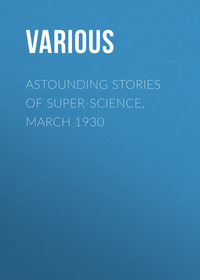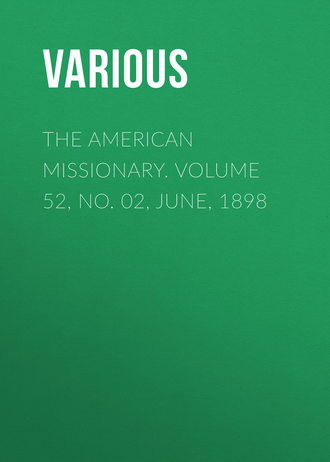 полная версия
полная версияThe American Missionary. Volume 52, No. 02, June, 1898

Various
The American Missionary – Volume 52, No. 02, June, 1898
EDITORIAL
THE FINANCIAL STATEMENT
The outlook for the American Missionary Association while hopeful, yet appeals most earnestly for increased contributions. The debt has been steadily reduced. At the Annual Meeting in 1895, it was reported to be $96,147. At the Annual Meeting in 1896 it was $66,572. At the last Annual Meeting it was $54,945, and now at the close of eight months of this fiscal year, May 31st, it is $39,527—a reduction from the highest figure above of $56,620. This reduction is largely due to the cutting down of expenditures, which has now reached a limit beyond which no friends of these needy races would wish it to pass. For these last eight months the total receipts show an increase of $25,800 in legacies, and at the same time a decrease of $22,800 in collections.
In view of these facts the duty is plain. Further reductions should not be made. The income from legacies is an uncertain quantity, and an increase of contributions is the only hope that can be given. Better times are coming, the responsibility to the poor of our land is urgent, and the generous response of philanthropic and Christian givers alone can meet the emergency.
SUCCESS IS COSTLY
When the early Abolitionists entered upon their contest against slavery, they found that they had no holiday business on hand. Some faltered, but others grew stronger as they realized the greatness of the conflict before them. They saw that their warfare would cost much in reputation, money, and even life itself. They succeeded, but only because they were willing to pay the cost.
When the next form of the conflict came—the terrible Civil War—the cost was so great as to be without a parallel in human history. That great cost was paid and success was won—a crowning success that could only come because the full cost was paid. And now the third part of the struggle confronts us—the redemption of the millions of blacks still in the bondage of poverty, ignorance and vice. This is the culmination of these past conflicts. If this be not successful, the rest has been in part in vain. Four millions of slaves were freed, and now four millions of their descendants are as helpless and hopeless as they—as great a curse to themselves and as dangerous an element to the nation. Now this great and crowning struggle is upon us. Other interests may for a time hide it from view, but it must be met, and here again, only that which costs will win. It is to be hoped that prosperity will return and make it easier to raise the needed funds. But continued depression will not hinder, for, as in the past, so here, self-denial and self-sacrifice will bear the burden which God has imposed, and the result will be success. Our appeal, therefore, for aid in this great conflict is not based on a mere hope of a better financial outlook in the nation, but on the consecration and benevolence of those who are ready to win a success that costs.
WAR AND ITS RESULTS
If war is simply to kill people and destroy property, it is an unmixed calamity. But often there are great and valuable results. Our War of Independence gave birth to this nation and to its amazing possibilities. The civil war confirmed the unity of the nation and wiped away the blot and curse of slavery. The present war with Spain is waged for the humane purpose of delivering Cuba, our near neighbor, from manifold forms of oppression, crippling its life, hindering its industries and impoverishing its people. It is earnestly to be hoped that the results of the struggle will secure deliverance from these evils.
Other blessings are already beginning to be realized. The war unites the North and the South as they have not been for thirty years. Our diverse peoples are united in enthusiasm under a common flag. The colored people of the country invited to join the armies are yet in some portions of the country received coldly or even with taunts and abuse. But they bear it all cheerfully, devoting themselves to the interests of our common country. Two brief extracts from papers edited and published by colored men give evidence of their patriotism and forbearance under these trials.
From the Fisk Herald, Fisk University, Nashville, Tenn.:
"The duty of the colored citizens of America in the impending conflict between our country and Spain is clear, and we are exceedingly glad to note that they are eager to go to the front to uphold the United States in its just demands upon Spain for the freedom of Cuba. No people ought to sympathize more with the oppressed than the negroes of America."
From the Christian Recorder of the A. M. E. Church:
"At all times the colored citizens of this country have proven loyal to the Government, and while they smart under the unjust treatment accorded them here, at no time and under no circumstances have they shown a lack of patriotism when the conditions demand it.
"In the present crisis the colored citizens are maintaining their past record for loyalty and devotion, and though our soldiers of color have been insulted and subjected to great indignities while on their way to defend their country, still their patriotism is not lessened nor their ardor cooled."
THE COLORED PEOPLES OF CUBA
We understand that about a half a million of the people of Cuba are Negro or mulatto, making nearly one-third of the population, and we learn that there is no such race antagonism between these Negroes and the Creoles as there is with us. The Maceos, who are among the finest specimens of patriotic manhood on the island, are mulattoes. If now, Cuba should be made free and become a part of these United States, these colored people would claim the sympathies and services of the American Missionary Association in giving to them those educational and religious advantages so promptly and freely given to the emancipated blacks of our own land. Such a service would bind these two peoples together and aid in uplifting both to the intelligence and privileges of free Christian citizens.
MISSIONARIES MURDERED IN WEST AFRICA
It is with heartfelt sorrow that we chronicle the murder of six missionaries in West Africa. They were sent by the Society of United Brethren in Christ, whose central office is in Dayton, O., and which has for many years carried forward very successful work in the Sherbro country, Sierra Leone, West Africa. This mission was contiguous to the Mendi Mission, founded by the A. M. A., and worked with it in Christian harmony and fellowship. When the Association retired from foreign mission work, the Mendi Mission was turned over to the Sherbro Mission, and aid was furnished for a time with funds from our board.
The slaughter of these devoted missionaries was brought about in consequence of a tax on houses or huts imposed by the Sierra Leone government. The savage people in the remoter districts pushed forward a resistance to this tax, and, confounding all white men and women together as responsible, committed these murders and destroyed mission property. Redress may come for property destroyed and other missionaries may take the place of those who have fallen, but we mourn for those who have been martyrs in the cause of the Master.
WORKING, THINKING, WRITING
To print a newspaper, though it be a small one, requires dexterous hand work. To publish such a paper demands business gifts to secure means and to plan the work. To edit such a paper calls for readable and racy writing. Few forms of business require a greater variety of manual, skilful and facile ability. For these reasons we are glad to find that in nearly all our larger schools in the South, monthly papers are printed and published—with little or no expense to the Association. The printing office teaches a useful and profitable trade to the student, the editing is usually done by the professors and students, and the publishing is managed so that by the aid of advertising and paid subscriptions, the expense is mainly met. These periodicals contain much valuable information. The professors contribute well-written papers, the students furnish articles or copies of orations or essays delivered on public occasions, and the graduates write sketches of their life struggles and successes since leaving the institutions. Well selected items from the world outside enrich these pages, and brief, personal paragraphs give varied and useful local information. We present below a partial list of these publications, giving their name, place of publication, size, etc.
The Fisk Herald, published by the literary societies of Fisk University, Nashville, Tenn., is a pamphlet of 24 pages, with an editor-in-chief and assistants selected from the students. The price is 75 cts. a year.
The Olio is published by the printing department of Straight University, New Orleans, La. This also is a pamphlet, of 20 pages. Price, 25 cts. a year.
Talladega College Record, published by the printing department of Talladega College, Talladega, Ala., is a four page sheet well printed, edited by students appointed for the purpose.
Tougaloo News. A well-printed sheet, 8 pages, issued quarterly at Tougaloo University, Tougaloo, Miss.
Head and Hand. Issued monthly from the Normal Training Department of Le Moyne Institute, Memphis, Tenn., a four page sheet, 25 cts. a year. It is now in its 12th volume.
The Word Carrier, published by the Normal Training School press at Santee Agency, Neb., is a four page paper edited and published by Rev. A. L. Riggs, D.D. This sheet, well printed and well edited, is now in its 27th volume, and presents many important phases of the Indian life and work. 50 cts. a year.
The Gloucester Letter, devoted to education and industry, published monthly at Cappahosic, Gloucester Co., Va., Prof. W. B. Weaver, editor; a four page publication in its tenth year, price, 50 cts. a year.
The Parish Visitor, the official organ of the First Congregational Church, Atlanta, Ga., a church paper edited by Rev. H. H. Proctor, with several assistants. 25 cts. a year.
The South
SAMPLES AND EXAMPLES
BY SECRETARY A. F. BEARDIt is my lot on the routes of less frequented travel to fall in with a class of my fellowmen distinctively known as "Commercial men." It is their business to be both inquisitive and communicative. While waiting at some little tavern or railroad station often the right hand of fellowship has been extended to me with the question "What is your line?" or "I see you have no trunks, how do you carry your samples?" They do not always quite understand "our line" when I tell them that our samples have learned to carry themselves and even to carry others. Then I am called to explain how they began their intelligent life with us, how we took the raw material and in process of time sent out our products from our schools and institutions with their thought of life widened, with enlarged mental vision and the great majority of them with hopeful religious characters and purposes. Sometimes these fellow travelers hear, and sometimes I marvel because of their unbelief. If our readers could see our samples as we see them in their varied vocations and places they would not soon forget them.
Not long since in Alabama I came across certain ones which are types; and as types I present them. The environment which conditions their work and gives the color of it must needs be included. Situated among the hills of Eastern Alabama is a thickly settled community of people about two-thirds of whom are colored. It is in the County of Elmore, and bears the Indian name of Kowaliga. Being near the corner of two adjoining counties, it is a rural centre from which large numbers of children can be reached who ought to be educated, and who are anxious to "get an education" as their one chance in life, a chance which so far has been beyond them.
Kowaliga settlement is remote from any railroad and consists wholly of plantations. These plantations were formerly tilled by slaves, but since freedom came to those who gave their unrequited labor, the rich white planters have become poor and many of their sons now may be seen themselves following their plows, tilling the fields and driving mules instead of men. The country is fertile and repays intelligent tillage.
The American Missionary Association has been applied to repeatedly for help in this settlement of Kowaliga. Under the lead of two young college graduates, both of whom I had met while they were students at Fisk University, the colored people with great sacrifice had contributed building material and labor in the construction of a very substantial two-story building with attic and basement, which, however, is yet incomplete and unfurnished. The people with few exceptions, are extremely poor and very ignorant, and have an imperfect idea of what a school means with its proper appointments and teachers.
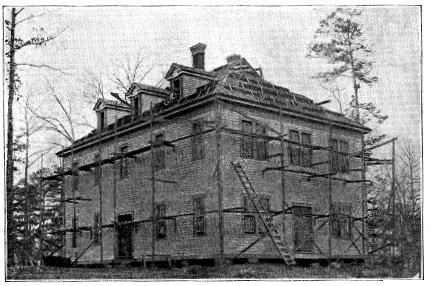
Kowaliga Industrial School.
In answer to the most urgent appeals of the two young educators, I arranged in my recent journeying in the South for a personal investigation. One of the former student acquaintances came for me in his "one horse shay" and with him as my courier and companion I rode through this rural district. I found that the white farmers are gradually leaving their plantations while the colored people are as gradually becoming land owners. Abandoned farms, which through poor culture have not paid the farmers for cultivation, can easily be secured by industrious colored people who are willing to deny themselves and work hard for an independent start in life.
The father of the young man whom I accompanied on my long ride through the country is one of these who has already won his success. His experience and achievement are typical in illustrating the trends and the probabilities.
Mr. J. A. Benson—at this present time forty-six years of age—was born a slave three miles from the great plantation which he now owns. When his owner's estate was divided he was a part of the property which fell to an heir in Talladega, Alabama. There as property he was sent, and there he worked as a slave until emancipation came. At the age of nineteen years, with a hundred dollars saved from his earnings as a free man he returned to his birthplace and purchased on credit 160 acres of land. His first year of crops gave him a handsome profit and soon he was able to pay for this land. Again he bought land, and again more year by year. Now I found him with his new house of twelve rooms nearly completed on the site of his old one, the construction of which was under the direction of a Negro contractor whose leading workman was a white man; a native of that same community. The mason who did the masonry was also a Southern white man. While engaged on this "job" both white men ate at the same table with the owner. In the "Merchant of Venice" we read of one who said, "I will buy with you, sell with you, talk with you, walk with you and so following, but I will not eat with you." Nevertheless there are times when "Necessity knows no law" and this was one of the times. It was the common opinion, however, that the excellent mason was much more expeditious than is common about his job, though he was working by the day. His work was completed in about one-half the usual time allowed for it. He stayed, not upon the order of his going. Doubtless a second experience would come with less self conquest than the first.
Mr. Benson began his independent life with his unpaid farm of 160 acres. Now he owns 3,000 acres of land paid for and without encumbrance, with the virtual ownership of a fine stream, at some points 500 feet wide, which for five miles runs through his extensive plantations. On this stream he has a brick yard, a saw mill, a grist mill and a cotton gin and compressing mill combined in one and operated by the water of this stream. The farm is worked on shares chiefly, the owner furnishing the land and the stock, the laborers dividing the products half and half.
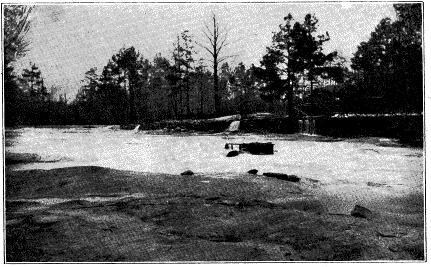
Kowaliga Creek—through Mr. Benson's Plantations.
The leases are taken by a dozen responsible and experienced farmers, who sub-contract with the laborers under their immediate supervision. Of the 3,000 acres, one-half is devoted to corn, cotton, cane, etc.; 500 are used for pasturage and 1,000 furnish ample supply of pine, oak and hickory timber for the greedy teeth of his saw mill and the willing embrace of his planing mill. He has cows, cattle, mules, horses, barns and farm implements to meet all necessities. His teams go regularly to Montgomery markets and return with stores for the forty families who live upon his lands and work them, and for the community who purchase of him what things they have. Besides his possessions in land, Mr. Benson has been able to loan to his white neighbors some $6,000, which are secured by mortgages upon their farms. They are running behind and he is running ahead. While I was the guest of this man, opposite me at the table dined a white man who was engaged on the carpentry of the new house. He was a native Southerner but he showed no evidence of social injury, and if he did his carpentry work as thoroughly as he did that of the table he certainly earned his wages.
Mr. Benson has managed with his uncommon ability to pick up education enough to achieve and handle successfully and shrewdly these large interests; not only to know their details but also to realize their significance and somewhat of the larger world beyond his own dominions. The success of this self-made colored man may be somewhat exceptional in degree, but it is not at all phenomenal. The story with the variations of personality and place could be told a hundred times over among the colored people who began thirty years ago without a foot of land or a dollar of money.
Among the colored people in this rural community this man is one. For the most part life has gone on for the others without much advancement. They have not been left without a certain kind of school for their children taught for three months out of twelve chiefly by students who are themselves getting an education in institutions sustained by Northern benevolence; but the teaching has been without continuity and insufficient to make much impress on character. This far-seeing colored man realized this, and his own influence in life might have been greater if chances had come to him in his earlier days. He has, therefore, given his son a liberal education at college and has daughters now in the same path.
When the young man returned from his studies with Christian love in his heart to assist his father in business he took in the situation that there must be a school here commensurate with the needs, where the colored boys and girls might receive the blessings of an education large and thorough enough and of such a positive Christian quality as should change the life of the community. In some aspects it sadly needs radical change.
He called to his side one of his mates at Fisk University—a graduate of the college department—under the conviction that for such work as this there was a call for a thorough as well as a technical education; that there must be breadth of mental knowledge and mental vision as well as skill of hand. The young college man with his diploma in his pocket heard the call, as scores of samples from our institutions in our great system of schools are hearing theirs every year; and when once there these two young men began what is to be the Kowaliga Academic and Industrial School. They each had taken industrial training enough with their studies to know what they were about. They sought good counsel from others and thus the main school building was begun. Mr. Benson, the father, furnished a sufficient allotment of land for the site, the timber and the lumber which his mills sawed and planed, and which his teams carted. The Samples supervised and the young people and old wrought with their own hands. Generous friends from the North lent their names to the undertaking and from and through them contributions came in amounts sufficient to encourage but not large enough to complete. From these were named an advisory board of friends who with an equal number of colored people in the neighborhood were called trustees.
These are the conditions in which I introduce our Samples. It was at this stage of the proceedings when these children of the American Missionary Association called to us for the second and third time, "Come over and help us." We came, we saw, and they conquered. How could we do other than honor their faith and patience with our "watch and care," and with a little faith on our part that help enough would come to us to make their own helpfulness successful. Here in the darkness these light bearers will give light and save life and they will do this better because light has been given to them and they themselves have been saved.
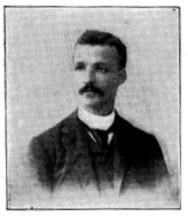
Prof. T. S. Inborden.
Principal Joseph K. Brick Normal, Agricultural and Industrial School at Enfield, N. C.—A. M. A.—born a slave. Struggled up through poverty, educated himself by teaching vacations and working his way. Was graduated from Fisk University. A Sample.
I have given this story of Samples because it is our latest. Our picture would be out of perspective, however, should it lead any to the conclusion that this typical illustration of conditions and work is other than a sample in itself. Let it be known that this is what is going on in the work of the American Missionary Association constantly year by year, every year, as it reduplicates itself in every State of the South.
Above ten thousand of these Samples are examples. They have taken the torches lighted at our fires and have borne the light of their knowledge on to others in darkness. They are doing it this year. They will do it next year. There are entire counties in the South in which our schools have supplied nine-tenths of all the colored teachers. These teachers, graduates of Normal Schools and higher institutions, are good samples, making full proof of their enlarged powers in the Christian upbuilding of their own race. The man who thinks leads.
Samples, also, in strong ministers of Christ, good and true, who are in "our line," planting little churches and developing little churches into larger ones, bringing dependent churches forward into self-support, and leading the colored people out and away from old-time superstition and evil ways into the pure life of intelligent faith.
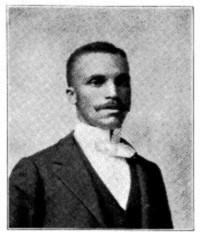
Prof. James L. Murray.
Born a slave. Educated by his own endeavors. Taught his way through College. Was graduated at Fisk University. Principal of the Albany Normal School, A. M. A. A Sample.
In the more conspicuous places of life we find our Samples. Some of their "examples" are already on the shelves of science in our libraries, and are hanging in honor in the galleries of art. Not a few of our graduates fill Professors' chairs. Many are already teachers of teachers. They believe that the Negro has intellect as well as hands. They believe in the development of manhood and womanhood along all lines, and do not believe that an elementary education for an elementary people is enough to save a race. They have been taught in our schools that our thought of education is that the knowledge which is of most worth "is that which stands in closet relation to the highest forms of the activity of the spirit created in the image of Him who holds nature and man and life alike in the hollow of His hand." Our idea of the educational process is that it is vital and not merely technical; that it is indeed but another name for the unfolding and growth of the human spirit. It has not, therefore, been along a single line of material helpfulness, and its ends are not reached with mere technical skill.
Our supreme purpose is "to give light and to save life," but we have never tried to save disembodied spirits. We have written Christianity large over and in all of our work in the school rooms, in the manual training shops, in the farm instruction, because we are sure there is no recuperative energy in the colored race, nor in any other, sufficient to save itself. There is nothing so practical to uplift men or races as Christianity. Said Archdeacon Tiffany the other day at Yale, "A prevailing idea is, to create an environment is to develop Christian life. Put people in the right places and they will be all right, a statement, however, which experience has denied from the Garden of Eden until now. Environment is a great factor but it does not furnish the life impulse. Recognize the help of environment but do not depend on it. How often environment does not make character but may retard it." Our work strikes its roots far deeper than in externals. Nevertheless, Christianity assumes intelligence and depends upon it. With Christian character and intelligence we hear the call for technical skill and provide for it in our industrial annexes side by side with our work in mental development. Hence you will find the Samples "in our line" as easily as a commercial traveler finds the stores which handle his goods.











